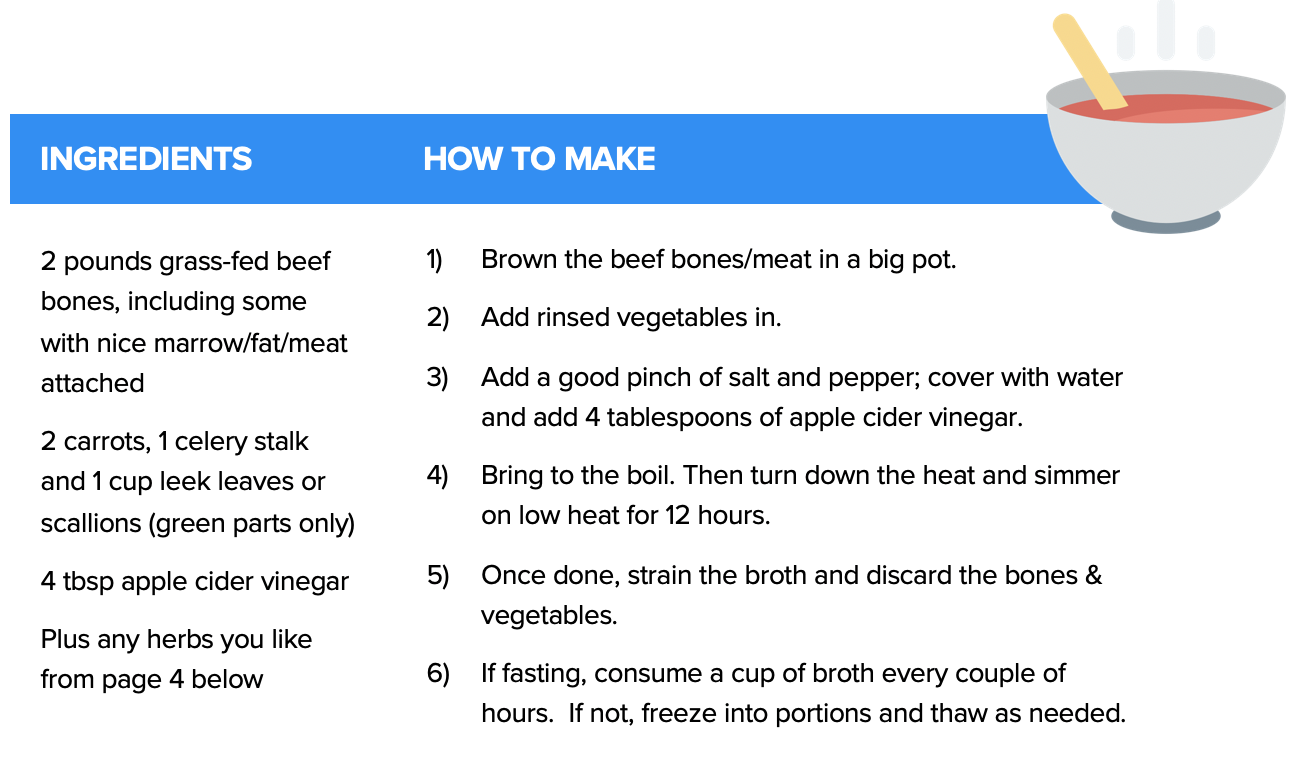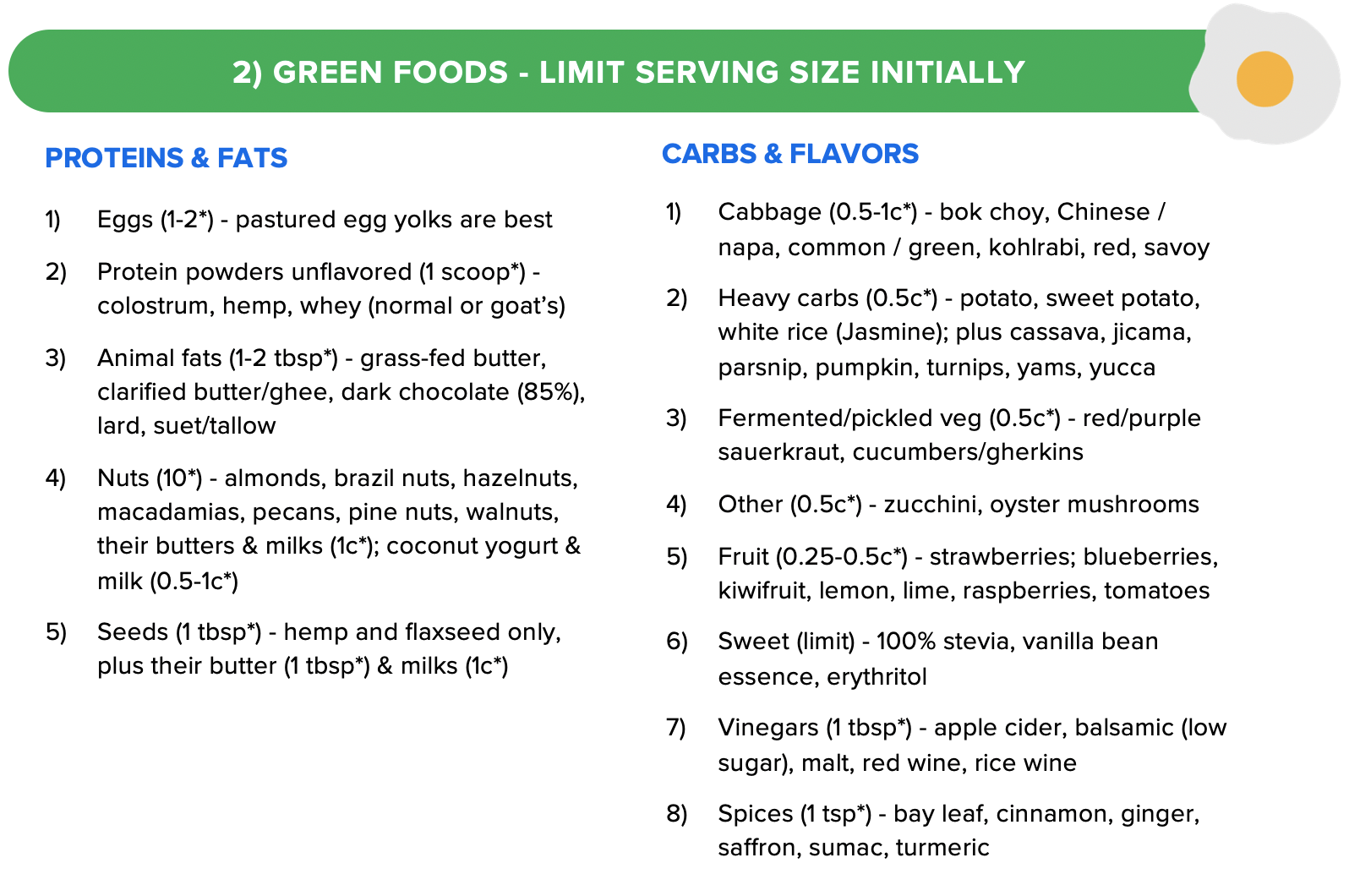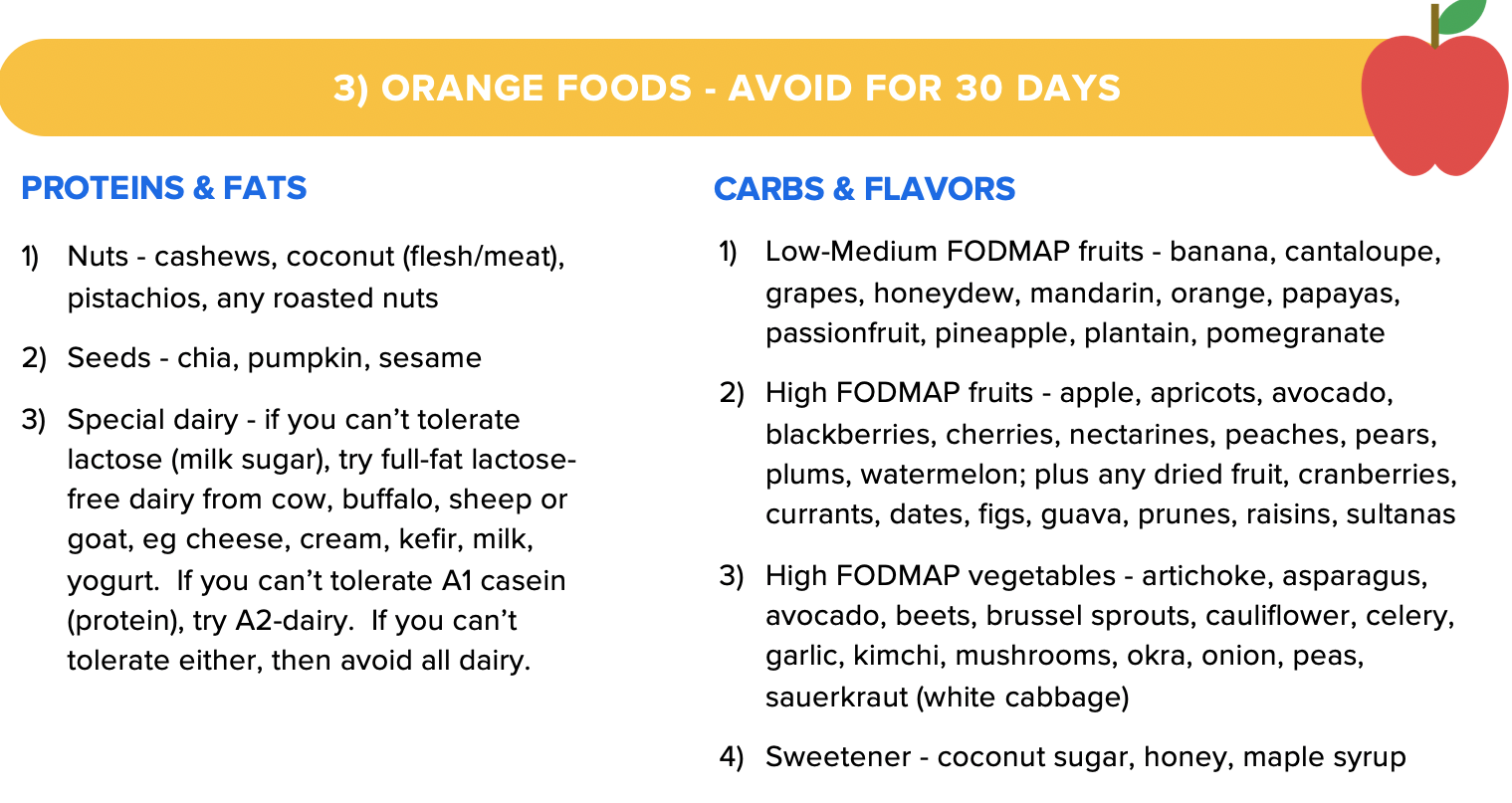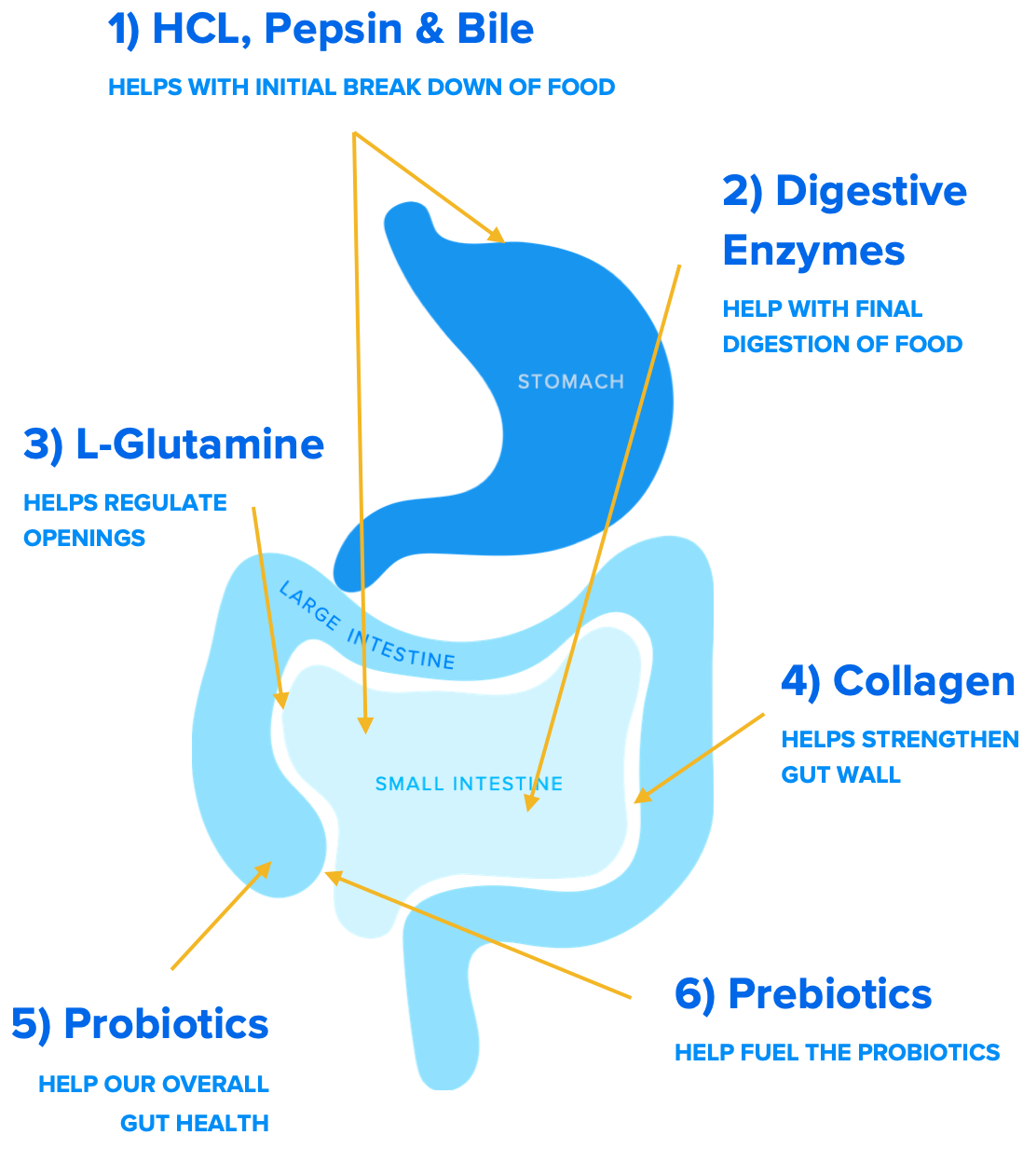Have you been trying to fix your leaky gut, but struggled to get any results? And have you been overwhelmed by all the information out there on leaky gut? Well, in this ultimate guide to treating leaky gut, we’re going to make thing super clear.
Last Updated: Nov 18, 2023

In this guide, you’ll discover…
This is my ENTIRE leaky gut recovery protocol, finally distilled into one place!
After 1000s of hours of research, trial & error, these are the very best lessons I’ve learnt.
As you’ll see, we will dive deep into exactly what foods, drinks and lifestyle habits can best help heal your leaky gut over the next 30 days.
Plus what supplements can be worth trying.
There is a lot of information, I know!
So if you want to get it in an easy-to-follow format, then download the free ebook version of this post.
Today is a very special day! Because you are about to discover exactly what to do to recover from leaky gut syndrome (aka intestinal hyperpermeability1).
You will not only learn the major causes of leaky gut to avoid, but also specifically what to eat and drink. Plus, you’ll uncover the smartest habits and supplements to help make the journey even easier.
However, after you’ve learned these steps, it’s all up to you to put them into practice. It will seem hard at times. And it will take some serious discipline.
But just keep working at it with your health practitioner for the next 30 days and before you know it you’ll feel like your old self. Happy, energetic, light and ready to take on life again.
You got this!
If you do the protocol right, here’s a sneak peek at my 4 favorite benefits you should see.
1) Peaceful Gut
By avoiding the key causes of leaky gut, plus eating & drinking clean, and adding some healthy habits and helpful supplements in, we can usually enjoy a peaceful gut free of leaky gut symptoms fairly soon.
Most people find beautiful bowel movements (as I like to call them) start about 1 week into the protocol.
2) Effortless weight loss
This may be THE greatest bonus benefit of this protocol! And it happens fast if you’re vigilant in following the protocol’s anti-inflammatory and low carb/sugar diet, plus avoiding alcohol. Typically, within 10 days of commencing the protocol.
Importantly, the types of foods we can eat (eg healthy fats & proteins) are amazing at satiating us2 and eliminating food cravings3.
3) Better energy, skin and mood
A personal favorite of mine is how well the ideas in this guide work for how we feel and look4. As we go through the 30 days it can almost feel like we are reverse aging!
We’re less tired when we wake up, our skin looks healthy & fresh, and we are just so much happier. Amazing!
4) Other benefits
By addressing our leaky gut syndrome, many people find other health issues improve, especially those related to the autoimmune system5,6. These benefits can be truly life changing.
But it is worth noting, they can also take longer to be felt than the above benefits. Working with your doctor and having patience is thus a true virtue.
A quick look at the 5 leading causes of leaky gut so you know exactly what to avoid over the next 30 days.
1) Inflammatory foods
 This is the big one! In fact, you can eliminate all the other causes below, but if you ignore this, you’ll never say goodbye to leaky gut.
This is the big one! In fact, you can eliminate all the other causes below, but if you ignore this, you’ll never say goodbye to leaky gut.
The main foods to avoid are: most grains (especially those with gluten7 – wheat, barley, rye), sugar8 (refined & natural), processed foods, unhealthy ‘vegetable’ oils (eg canola oil), artificial sweeteners, plus most legumes, soy products and normal dairy9.
In particular, we want to make sure we’re avoiding gluten, as this increases zonulin levels10 – a protein, that may exacerbate intestinal permeability, i.e. leaky gut11,12.
To make sure you know exactly what foods to avoid I’ve created a detailed list further below.
2) Gut-irritating drinks
 The big ones to avoid are those filled with alcohol13, caffeine14,15, sugar, artificial sweeteners and high FODMAP ingredients16 (eg fructose in fruit juice).
The big ones to avoid are those filled with alcohol13, caffeine14,15, sugar, artificial sweeteners and high FODMAP ingredients16 (eg fructose in fruit juice).
This is almost as important as avoiding inflammatory foods, so I will also run through a full list of ‘no’ drinks below.
And before you despair, keep in mind, many of these drinks can come back into rotation as our gut health improves.
3) Medications & OTC drugs
 Many medications and OTC drugs can exacerbate leaky gut. Whilst NSAIDs for example can directly damage the gut lining17,18, others, like steroids19, antibiotics20 and antacids21, can impact gut bacteria balance and stomach acid production, further weakening the system.
Many medications and OTC drugs can exacerbate leaky gut. Whilst NSAIDs for example can directly damage the gut lining17,18, others, like steroids19, antibiotics20 and antacids21, can impact gut bacteria balance and stomach acid production, further weakening the system.
Speak with your doctor to determine what you can remove/limit, as immediate cessation without supervision can be dangerous.
4) Stress & poor sleep
 Chronic stress22 and low quality sleep23 can be as bad as gluten for your gut, since they can weaken your intestinal lining, slow your digestive capacity and throw your gut flora out of balance.
Chronic stress22 and low quality sleep23 can be as bad as gluten for your gut, since they can weaken your intestinal lining, slow your digestive capacity and throw your gut flora out of balance.
I also know that the causes of them (work, family, social etc) can be just about as hard to avoid as gluten itself! But I’ve got some smart management techniques, which I’ll discuss below.
5) Related gut health issues
 Unsurprisingly, the overlap of people with leaky gut and IBS/SIBO24,25, candida26 and/or reflux, is becoming increasingly prevalent.
Unsurprisingly, the overlap of people with leaky gut and IBS/SIBO24,25, candida26 and/or reflux, is becoming increasingly prevalent.
It is still unclear which causes which, but this protocol takes them ALL into account, including the revolutionary low FODMAP diet for IBS27. More on this below.
A 48-72 hour broth fast is one of, if not the fastest, way to feel better. Get ready to fall in love with this simple, low cost leaky gut treatment idea!
Why I love bone broth fasts for leaky gut
Whilst our leaky gut diet (packed with healthy fats, clean proteins & nutrient-dense vegetables) is fantastic at slowly healing the gut – and maintaining its good health long term – it doesn’t compare to a bone broth fast when it comes to rapidly making us feel better.
The fast itself (i.e. no solid foods for 2-3 days) has two benefits.
First, it will give our digestive system a much needed break. Second, it will ensure no more large food particles are making their way through our leaky gut and into the bloodstream.
That in turn means inflammation can cool down and the immune system will also get a chance to regroup. Think of the fast like a spa weekend for the digestive system!
Meanwhile, the bone broth itself has a huge benefit for our gut, because the collagen in it (a protein) delivers a huge serving of the types of amino acids our GI tract feeds on in order to repair itself – eg glycine, proline and hydroxyproline28,29,30.
These 3 amino acids for example, work great to mend the damaged cells lining the wall of our gut. Amazing!
How to make my bone broth, the easy way
Ingredients
- 2 pounds grass-fed beef bones, including some with nice marrow/fat/meat attached
- 2 carrots, 1 celery stalk and 1 cup leek leaves or scallions (green parts only)
- 4 tbsp apple cider vinegar
- Plus any herbs you like from the food list below
Directions
- Brown the beef bones/meat in a big pot.
- Add rinsed vegetables in.
- Add a good pinch of salt and pepper; cover with water and add 4 tablespoons of apple cider vinegar.
- Bring to the boil. Then turn down the heat and simmer on low heat for 12 hours.
- Once done, strain the broth and discard the bones & vegetables.
- If fasting, consume a cup of broth every couple of hours. If not, freeze into portions and thaw as needed.
Don’t like the taste of bone broth?
You can also enjoy collagen in powder form. The most absorbable & tasteless form is hydrolyzed collagen like this one (widely known as ‘collagen peptides’). I talk more about this below.
So what foods are we eating over the next 30 days?
We’ll be eating a Paleo/AIP meets low FODMAP diet
That means we’re going to enjoy lots of nice fish, seafood, meat, healthy oils & clean vegetables. Plus some quality nuts, eggs and a moderate amount of other carbs, like low-sugar, low-FODMAP fruit.
With that said, the vast majority of the calories will come from healthy fats and clean proteins. Meaning this leaky gut diet borrows ideas from the paleo/AIP (autoimmune protocol)31, keto32 and low FODMAP diets, and smartly blends them together.
Finally, one diet to rule them all.
But what we DON’T eat is even more important!
As we talked about under ‘Eliminate The Causes’, any food or drink that has a high chance of causing our gut inflammation and/or autoimmune reactions is out!
Avoiding these foods is the center of the leaky gut diet and actually more important than what we say yes to! Which is why you’ll find a detailed list of the ‘no’ foods below.
Moreover, research continues to come out showing how people with leaky gut often also have IBS33, SIBO34, candida35 and/or reflux36.
As such, I have decided to modify the leaky gut diet so that it can help us take on all 5 digestive issues at once, as well as related issues like bloating, diarrhea and gas37.
Not only is this super convenient, but it means the diet can work where others have failed.
So for the next 30 days we’ll also cut 2 groups of otherwise healthy foods & drinks
Group #1) Healthy foods & drinks that can be reactionary
The Problem
‘Healthy’ foods like the nightshades family, which includes tomatoes, peppers, eggplants and potatoes, can cause a reaction38 due primarily to a group of substances found in them known as alkaloids.
Whilst dairy – even lactose free dairy – can cause a response due to the casein protein39.
So too can other healthy foods like, normal eggs, which can create issues40 due to the imbalance of omega 3 v 6, as well as presence of lysozyme and particular proteins (in the whites), which can trigger an inflammatory response41.
Solution
We’ll completely remove some of these for 90 days (eg peppers), others for just 30 days (eg lactose-free dairy) and we’ll keep some others in, but in reduced amounts (eg tomatoes).
Plus we’ll prepare them better for digestion, eg anything with skin & seeds will be peeled & deseeded.
We’ll also focus on buying quality, eg pastured eggs have balanced omega 3 v 6 profiles42 and can be easier to tolerate.
Group #2) Healthy foods & drinks that are high in FODMAPs (poorly absorbed carbohydrates)
The Problem
When our gut is in bad shape these carbs are poorly absorbed, which can lead to excess fermentation and water in our intestine. This can then result in gas, bloating, diarrhea and all-round intestinal inflammation43,44.
Solution
For the next 30 days we will reduce or completely remove any healthy foods high in FODMAPs (fructans, galactans, lactose, fructose and polyols / sugar alcohols)45,46.
Unfortunately, this includes some of our old favorites like asparagus, avocado, cauliflower, garlic and even normal sauerkraut (white cabbage)47.
I will once again be sure to list them all out below, so it is very clear what you should consider avoiding.
The Brand New Leaky Gut Food List
Including Foods & Drinks To Avoid For Leaky Gut
1) BLUE FOODS

My absolute favorite foods to eat for leaky gut
These are the nutrient-rich foods that can nourish our digestive tract without causing further inflammation to our gut lining or excess fermentation in our intestines.
Most of the calories here come from healthy fats and proteins, which means these foods are also great at leaving us feeling satisfied.
PROTEINS & FATS TO GORGE ON
- Fish48 – anchovies, bass, cod, flounder, haddock, halibut, mackerel, salmon, smoked salmon, sardines, sole, trout, tuna
- Seafood49 – calamari/squid, clams, crab, mussels, oysters, shrimp, scallops
- Poultry50 – chicken, duck, goose, quail, turkey
- Meat – bacon, beef, goat, ham, lamb, pork, organs, bones (for broth); plus game – bison, boar, elk, rabbit, venison
- Protein powder – collagen (collagen peptides)51
- Plant oils52 – avocado, olive (inc extra virgin), perilla, rice bran, plus infused versions
- Nut oils53 – coconut, macadamia (unheated), MCT, walnut (unheated)
- Fish oils54 – cod liver, fish, krill
CARBS & FLAVORS TO ENJOY FREELY
- Lettuce55 – arugula, butter, cos/romaine, iceberg, mesclun, mustard greens, spring, radicchio, watercress etc
- Leafy56 – endive, kale, chicory leaves, fennel leaves, leek leaves, spinach, witlof
- Greens57 – choy sum, collard greens, cucumbers, swiss chard, broccoli, Chinese broccoli, green beans
- Other – bamboo shoots, bean sprouts, carrots, radish, rhubarb, seaweed/nori
- Salt – capers, olives, salt (sea / iodized / Himalayan), coconut aminos (like soy sauce)
- Herbs58 – basil, cilantro, dill, mint, parsley, oregano, rosemary, sage, scallions/spring onions (green part), tarragon, thyme
2) GREEN FOODS
 * Indicates max serving size per person, per meal. c = cup | tsp = teaspoon | tbsp = tablespoon
* Indicates max serving size per person, per meal. c = cup | tsp = teaspoon | tbsp = tablespoon
Generally healthy foods and suit most people, especially in smaller serving sizes
But some of them can cause issues/reactions for certain individuals initially, even at small sizes (eg nightshades).
So pay attention to your body when eating them, buy high quality (eg pastured eggs) and prepare them properly (eg peel & deseed tomatoes).
PROTEINS & FATS TO ENJOY IN LIMITED SERVINGS
- Eggs (1-2*) – pastured egg yolks are best / most easily tolerated
- Protein powders unflavored (1 scoop*) – colostrum, hemp, whey (normal or goat’s)
- Animal fats (1-2 tbsp*) – grass-fed butter, clarified butter/ghee, dark chocolate (85%), lard, suet/tallow
- Nuts (10*)59 – almonds, brazil nuts, hazelnuts, macadamias, pecans, pine nuts, walnuts, their butters & milks (1c*); coconut yogurt & milk (0.5-1c*)
- Seeds (1 tbsp*)60 – hemp and flaxseed only, plus their butter (1 tbsp*) & milks (1c*)
CARBS & FLAVORS TO ENJOY IN LIMITED SERVINGS
- Cabbage (0.5-1c*) – bok choy, Chinese / napa, common / green, kohlrabi, red, savoy
- Heavy carbs (0.5c*) – potato, sweet potato, white rice (Jasmine); plus cassava, jicama, parsnip, pumpkin, turnips, yams, yucca
- Fermented/pickled veg (0.5c*) – red/purple sauerkraut, cucumbers/gherkins
- Other (0.5c*) – zucchini, oyster mushrooms
- Fruit (0.25-0.5c*) – strawberries; blueberries, kiwifruit, lemon, lime, raspberries, tomatoes
- Sweet (limit) – 100% stevia, vanilla bean essence, erythritol
- Vinegars (1 tbsp*) – apple cider, balsamic (low sugar), malt, red wine, rice wine
- Spices (1 tsp*) – bay leaf, cinnamon, ginger, saffron, sumac, turmeric
3) ORANGE FOODS

These are healthy foods that can be hard to tolerate initially when our gut health is bad
That’s because they have short-chain carbs (FODMAPs) that can be poorly absorbed, which can lead to excess fermentation and water in our intestine. And in turn gas, bloating, diarrhea and all-round intestinal inflammation61.
So avoid for the next 30 days whilst bacterial balance is restored. Then test them one-by-one with a Registered Dietitian (RDN) using the Reintroduction Diet method.
PROTEINS & FATS TO AVOID FOR NOW
- Nuts – cashews, coconut (flesh/meat), pistachios, any roasted nuts
- Seeds – chia, pumpkin, sesame
- Special dairy – if you can’t tolerate lactose (milk sugar), try full-fat lactose-free dairy from cow, buffalo, sheep or goat, eg cheese, cream, kefir, milk, yogurt. If you can’t tolerate A1 casein (protein), try A2-dairy. If you can’t tolerate either, then avoid all dairy.
CARBS & FLAVORS TO AVOID FOR NOW
- Low-Medium FODMAP fruits – banana, cantaloupe, grapes, honeydew, mandarin, orange, papayas, passionfruit, pineapple, plantain, pomegranate
- High FODMAP fruits62 – apple, apricots, avocado, blackberries, cherries, nectarines, peaches, pears, plums, watermelon; plus any dried fruit, cranberries, currants, dates, figs, guava, prunes, raisins, sultanas
- High FODMAP vegetables63 – artichoke, asparagus, avocado, beets, brussel sprouts, cauliflower, celery, garlic, kimchi, mushrooms, okra, onion, peas, sauerkraut (white cabbage)
- Sweetener64 – coconut sugar, honey, maple syrup
3) RED FOODS

Say hello to the highly troublesome foods we should avoid now, and possibly, permanently
These foods are packed with a range of anti-nutrients like lectins, sugar, gliadin etc, which disrupt gut function and irritate our intestinal lining65.
Avoid them for the 90 days, then once gut health gets better test them one-by-one, under the supervision of a Registered Dietitian (RDN).
Consider permanently avoiding vegetable oils, grains with gluten, refined sugar & artificial sweeteners listed above.
Note: the majority of packaged foods, eg sauces, dressings, marinades etc, contain one or more of these red leaky gut foods to avoid (especially unhealthy ‘vegetable’ oils like canola oil), so inspect labels carefully.
PROTEINS & FATS TO AVOID
- Conventionally farmed66 & grain-fed fish, seafood, meat, poultry, eggs etc due to unfavorable omega 3 v 6 profiles, plus potential for toxins like antibiotics, added hormones etc
- ‘Vegetable’ oils – canola, corn, cottonseed, flaxseed, grapeseed, peanut, safflower, soybean, sunflower, ‘vegetable oil’
- Vegetarian fats – margarine (where uses ‘vegetable’ oils above)
- Protein powders – casein, soy & most flavored protein powders
- Conventional dairy67 – ie cow’s milk, buttermilk, cream, custard, ice cream, milk chocolate etc, especially where flavored
- Any processed foods68
CARBS & FLAVORS TO AVOID
- Grains w gluten – wheat & varieties (eg spelt, kamut, durum) and products (eg bulgur, semolina), plus barley, rye, triticale; incl. end products like bread, cereals, cookies, couscous, noodles, pasta etc.
- Gluten-free grains – corn, millet, rice (brown, red, wild); plus pseudo-cereals like amaranth, buckwheat, quinoa
- Legumes69 – beans (all), chickpeas, lentils (unless pressure cooked), peanuts, soy (see next)
- Soy – beans, edamame, milk, protein TVP, tempeh, tofu plain/firm/silken
- Nightshades – eggplant, peppers (all), red spices
- Sugar – brown, cane, icing, palm, raw, white, sucrose / table sugar; incl. end products like sauces, dressings, prepared foods, ‘low fat’ foods etc.
- Natural & artificial sweeteners – agave syrup, aspartame, high fructose corn syrup, saccharine, sucralose; plus sugar alcohols isomalt 953, maltitol 965, mannitol 421, sorbitol 420, xylitol 967
- Alcohol70 – beer, cider, wine, spirits
- Coffee71 – including decaf
- Sweet drinks – soda, diet soda, tonic water, fruit juice/smoothies, energy drinks, sports drinks
How to eat these foods over the next 90 days
As you can see the key focus is on eating blue foods over the next 90 days, as well as green foods (first in limited serving sizes and then in larger sizes providing you don’t react badly to any of them).

Meanwhile, orange foods are to be left totally alone for the first 30 days. After which time they can be tested one-by-one.
Although, red foods & drinks can eventually be brought back into the fold, you should be very careful and see how your body responds.
These are my 7 favorite meals to eat during a 30-day healing protocol. Designed to inspire your own ideas.
Recipe #1 – The Clean Protein Shake
Ingredients (Serves 1)
 1 handful of ice – to make the other ingredients taste nice and chilled.
1 handful of ice – to make the other ingredients taste nice and chilled.- 10 oz / 300 ml of liquid – filtered water or a combo of water and a nut-based milk if you want it to be a bit richer in flavor. My favorites are almond and macadamia.
- 1 handful of green vegetables – fresh baby spinach is best, as it doesn’t taste too bad when raw. Note: I used to pre-cook my spinach to reduce presence of oxalates, but it is so inconvenient and only offers a minor benefit.
- ¼ cup low-sugar, low-FODMAP fruit – my favorite options are either in-season strawberries or blueberries. Frozen can work too.
- 1 scoop protein powder – unless I’ve just been training this is pretty much always collagen protein, aka collagen peptides, since this type of protein helps more with the gut, than muscles. 10g scoop is perfect amount.
- 1 tablespoon healthy fats – either MCT or coconut oil or better yet pure caprylic acid (C8) oil. These fats can be great at helping balance bad v good bacteria72. Otherwise, you can also consider extra virgin olive oil73.
How to make
No rocket science here. Just grab all the ingredients below and blend away in a blender.
Recipe #2 – My Lazy Simple Soup
Ingredients (Serves 2)
 20 oz / 600 ml of water and/or bone broth. Sometimes I add ¼ cup (low FODMAP size) of coconut milk74 as well. Delicious!
20 oz / 600 ml of water and/or bone broth. Sometimes I add ¼ cup (low FODMAP size) of coconut milk74 as well. Delicious!- 2 handfuls of vegetables – I either go with broccoli or choy sum.
- 2 handfuls of protein (about 8-10 oz / 300 g) – literally whatever I have in the fridge. From chicken thigh to brisket to shrimp, it all tastes amazing in this soup.
- 2 pinches of ‘flavor’ – eg sea salt, herbs and/or compliant spices (see page 10).
How to make
Toss it all in a pot, bring to boil and simmer till the protein is cooked.
Recipe #3 – Homemade Beef Bone Broth
 See above for my simple recipe. And keep in mind that this freezes great.
See above for my simple recipe. And keep in mind that this freezes great.
Making it super convenient to take out and enjoy any day you feel like it.
Recipe #4 – Roast Salmon Feast
Ingredients (Serves 2)
 2 fillets of salmon (about 8-10 oz / 300 g) – wild sockeye if possible.
2 fillets of salmon (about 8-10 oz / 300 g) – wild sockeye if possible.- 2 handfuls of vegetables – my favorite combo is green beans & Chinese broccoli.
- 1 cup (cooked) starchy veg – at this serving size we’ll stay low FODMAP & low carb. Normal potato or sweet potato are my go-tos.
- Some flavors – a bunch of dill, juice of 1 lemon, 2-3 tablespoons of grass-fed butter, 1-2 tablespoons of extra virgin olive oil, sea salt and 2 teaspoon of capers.
How to make
Oven roast the salmon for 25 minutes at 350 f (180 c), steam or boil the veg and boil the potatoes. Take it all off the heat and plate up.
Now simply cover with your flavors – I like to put dill & capers over the salmon, butter mashed into the potatoes and lemon, olive oil & salt over everything. See how simple leaky gut recipes can be!
Recipe #5 – My 20-Minute Steak Feast
Ingredients (Serves 1)
 1 steak – type and size depends on you! I usually go for nice fatty rib eye, as it keeps me satiated for ages. Who misses pizza when you’ve got this!
1 steak – type and size depends on you! I usually go for nice fatty rib eye, as it keeps me satiated for ages. Who misses pizza when you’ve got this!- 1 garden salad – whatever lettuce leaves are lying around, plus half a cucumber (peeled & deseeded) and 5 cherry tomatoes (deseeded). All tossed in a simple olive oil and lemon juice dressing, with a pinch of salt.
How to make
Bring steak to room temperature, season generously with sea salt, get skillet/BBQ hot, sear on each side, then finish in 450 f (230 c) oven for 10 minutes (flip halfway) – depends on cut and how you like your steak.
Take out & rest. Enjoy!
Recipe #6 – The Big Chicken Salad
Ingredients (Serves 2)
 2 fillets of chicken breast – pastured/free range if possible.
2 fillets of chicken breast – pastured/free range if possible.- Nice salad mix – my preference is usually 2 big handfuls of arugula, ½-1 cup of sliced raw carrot, 1-2 sliced radishes, and usually some cucumber & cherry tomatoes.
- Some flavors – for the dressing it’s usually going to be a 70:30 olive oil to balsamic vinegar mix with 1 teaspoon of Dijon and pinch of sea salt. Whilst the X-factor here is 2 tablespoons of pan-roasted pine nuts. No wonder I can eat this weekly!
How to make
Poach the chicken for about 15 minutes, then rest and slice. Meanwhile, wash, chop and mix all the salad together, along with ½ the dressing.
Plate the salad. Top with chicken. Pour over remaining dressing. And finally, sprinkle over the pine nuts.
Recipe #7 – My Guilt-Free Dessert Bowl
Ingredients (Serves 1)
 1 handful of nuts (10-15) – I like macadamias or hazelnuts, or a bit of both.
1 handful of nuts (10-15) – I like macadamias or hazelnuts, or a bit of both.- 1 tub unflavored coconut yogurt (4 oz / 120 g), with a few drops of stevia (to taste).
- 1 small handful of sliced strawberries.
How to make
Mix the yogurt & stevia together in bowl, pour nuts on top, then berries.
With dozens of different supplements to consider for gut health, what are the few that matter? Just six.

1) Betaine HCL, Pepsin & Bile
HELPS WITH INITIAL BREAK DOWN OF FOOD
These 3 ingredients help break down food so that your body can more easily absorb the nutrients and so that less undigested food particles bombard your gut lining.
I recommend you try this convenient blend of HCL/pepsin/bile, as I created it with my research team to meet the highest purity standards, including using pure lactose-free Pepsin.
2) Digestive Enzymes
HELP WITH FINAL DIGESTION OF FOOD
Digestive enzymes help complete the digestion process75 after HCL, pepsin & bile have done the initial break down work. This second step of digestion can make all the difference.
Consider our plant-based digestive enzymes, as we created them to meet the strictest criteria, including being gluten, dairy & soy free.
3) L-Glutamine
HELPS REGULATE OPENINGS
L-Glutamine is a remarkable amino acid, because it can directly feed the cells controlling the openings along our intestinal wall and in turn make our gut less permeable, or ‘leaky’76,77. As such it’s widely seen as the #1 supplement for leaky gut.
Just be sure to get a pure free-form L-Glutamine powder like this one for maximum absorption.
4) Collagen
HELPS STRENGTHEN GUT WALL
Collagen is a type of protein, which has a wide variety of amino acids that can further support a healthy intestinal wall78,79. In fact, it is the secret ingredient in bone broth!
So if you don’t like the taste of bone broth or find it inconvenient to make, then a flavorless collagen supplement is the way to go. Just be sure to try a high quality grass-fed collagen protein powder.
5) Probiotics
HELP OUR OVERALL GUT HEALTH
Probiotics are good bacteria, which help us digest food better80, improve weight management, support bowel movements, strengthen our immune system81 & most of all, our intestinal wall82.
Unfortunately, most probiotic supplements do very little as they are weakly dosed and use low quality strains.
The key is to look for one with a sizeable 30-50 billion CFUs per serve and 10-12 different strains like this probiotic my team and I developed after months of research & testing.
6) Prebiotics
HELP FUEL THE PROBIOTICS
Prebiotics are like fertilizer for the the good bacteria (probiotics) in our gut83. So by taking them we maximize all the amazing benefits of the probiotics.
The problem is most prebiotic supplements contain fibers that cause bloating and ‘bathroom issues’. That’s why we created this gentle organic prebiotic fiber.
Here are my 4 favorite ways to fight leaky gut each day through lifestyle. Habits that make a difference!
I’ve seen people eat the strictest diets and take all the supplements under the sun, but still not feel better. Why?
They still live a poor lifestyle. One filled with poor sleep, chronic stress & inactivity.
If you get your daily habits in order, you’ll finally find the missing piece of the puzzle. Use a habit tracking app to stay accountable.
1) Sleep 8 hours
 How is that possible?! Cut all electronics at 9pm, pop some magnesium citrate (200-400mg), eat 5-10 walnuts or macadamias, and just relax. Without screens.
How is that possible?! Cut all electronics at 9pm, pop some magnesium citrate (200-400mg), eat 5-10 walnuts or macadamias, and just relax. Without screens.
You’ll be amazed at how peaceful & long you can sleep.
2) Relax, seriously
 Have a sauna. Listen to soothing music like Bon Iver. Go for a walk. Drop the caffeine. Drink herbal tea. Block email. Put your phone in airplane mode. Don’t take things too seriously. Enter the present moment.
Have a sauna. Listen to soothing music like Bon Iver. Go for a walk. Drop the caffeine. Drink herbal tea. Block email. Put your phone in airplane mode. Don’t take things too seriously. Enter the present moment.
This approach to life can have a profound impact on your digestive health. Although it is a bit woo woo of me, I strongly recommend you read Eckhart Tolle’s Practicing The Power of Now.
3) Breathe or meditate
 Both of these can greatly reduce chronic stress and help with sleep.
Both of these can greatly reduce chronic stress and help with sleep.
For breathing, try Dr Weil’s 3 breathing exercises.
Meanwhile, for meditation try Headspace or the Transcendental Meditation technique (TM.org), which I absolutely love! Best of all, the the benefits of meditation go way beyond reduced stress. A true life changer!
4) Exercise lightly
 Just 7 minutes of daily HiiT can get the job done. Here’s what I use. But 30 minutes of yoga can be even better, especially since it incorporates many of the benefits of meditation.
Just 7 minutes of daily HiiT can get the job done. Here’s what I use. But 30 minutes of yoga can be even better, especially since it incorporates many of the benefits of meditation.
Whatever you do, just avoid hardcore steady-state cardio or heavy weights as they can stress the system at this early stage and further aggravate leaky gut.
To get better it is crucial to do the steps consistently over 30 days. So one month from now check:
1) Have you eliminated the causes?
Yes, I have cut the 5 main causes of leaky gut out of my lifestyle, including inflammatory foods, gut-irritating drinks, unnecessary medications/OTC drugs (under doctor supervision), stress & poor sleep, plus related gut health issues.
2) Have you fasted?
Yes, I have fasted for 48-72 hours consuming only bone broth and I have done 3 subsequent 24-hour fasts.
3) Have you eaten/drunken clean?
Yes, I have stuck to the Leaky Gut Food List (above), eating only blue and green foods, whilst also adhering to serving size recommendations for green foods. Have you supplemented smartly?
Yes, I have tried daily servings of L-Glutamine, collagen, probiotics and prebiotics, plus Betaine HCL and digestive enzymes with meals.
4) Have you practiced healthy habits?
Yes, I have managed to stick to my 4 new habits (sleep, daily relaxation, breathing/meditation and light exercise) during at least 20 of the last 30 days.
What if you’re still struggling with leaky gut after ticking the above boxes for 30 days?
Although most readers will find amazing relief over the next month, some may need more time to heal (approx. 3-6 months) and possibly an even stricter diet (ie eat blue foods ONLY) to get back to their best.
Especially if they are tackling multiple issues at once, eg SIBO (small intestinal bacterial overgrowth).
So the best idea is to continue ticking the boxes above and all with the supervision of your health practitioner.
If you get off to a good start and build some momentum, you’ll be almost unstoppable. Here’s how to do just that:
1) Today
First things first. Write down 3-5 specific reasons why you want to fix your gut health. For example, for me it was all about getting rid of the endless bloating, crazy bowel movements, endless food intolerances and reflux.
So get honest here, as this will motivate you to stick to the protocol for 30 days.
Now, go through your cupboard and fridge, and ditch (don’t just hide) all the ‘red’ food & drinks that appear above. Goodbye bread, cookies, pasta, vegetable oils, sugary sauces, beer, soda etc.
And for food today, try to just eat fish or meat, with a nice big salad dressed in lemon juice, salt and olive oil. And if time, take a 20 minute walk, turn off screens early (eg 8pm) and go to bed for a big sleep.
2) Tomorrow
Go shopping! Pickup your favorite foods from the ‘Leaky Gut Food List’ above, as well as a few of the supplements that sound best to you above.
When you get home, cook up a gut-friendly meal that sounds hearty & delicious – maybe even one of my sample recipes. Or, if you feel up to it, cook up the bone broth and consider trying a 24-72 hour bone broth fast. Plus, get some light exercise in and go to bed early again.
3) Next day
Write out a daily habit checklist for good gut health. Even just 3 habits you’ll promise to do each day for the next 30 days, will be awesome.
For example, you could promise to yourself to simply 1) eat no gluten or sugar, 2) limit alcohol to max 1 glass per day and 3) take L-Glutamine when you first wake up.
But if you’re feeling ambitious and really want to see a change, try pick 5-7 small daily habits to track over the next 30 days.
If you can get all that done over the next 3 days, you’ll be well on your way to becoming free of leaky gut and feeling insanely amazing again!
You’ve got this!
You know exactly what to do. Now you just need to start doing it! And before you know it, you’ll be feeling like your old self. In fact, when you’re feeling amazing in 30, 60 or maybe 90 days from now, let me know!
I’ve received 1000s of success stories over the years and they are why I get up every single day. So don’t be shy, I’d love to hear from you! You can contact me here.
Good luck my friend! I can’t wait to hear all about your success.
P.S. if you want the beautiful free ebook version of this post download it here.
References
- Obrenovich ME. Leaky gut, leaky brain?. Microorganisms. 2018 Dec;6(4):107.
- Cuenca-Sánchez M, Navas-Carrillo D, Orenes-Piñero E. Controversies surrounding high-protein diet intake: satiating effect and kidney and bone health. Advances in nutrition. 2015 May;6(3):260-6.
- Gilhooly CH, Das SK, Golden JK, McCrory MA, Dallal GE, Saltzman E, Kramer FM, Roberts SB. Food cravings and energy regulation: the characteristics of craved foods and their relationship with eating behaviors and weight change during 6 months of dietary energy restriction. International Journal of Obesity. 2007 Dec;31(12):1849-58.
- Leech B, Schloss J, Steel A. Investigation into complementary and integrative medicine practitioners’ clinical experience of intestinal permeability: A cross-sectional survey. Complementary therapies in clinical practice. 2018 May 1;31:200-9.
- Leech B, Schloss J, Steel A. Investigation into complementary and integrative medicine practitioners’ clinical experience of intestinal permeability: A cross-sectional survey. Complementary therapies in clinical practice. 2018 May 1;31:200-9.
- Yu LC. Intestinal epithelial barrier dysfunction in food hypersensitivity. Journal of allergy. 2012;2012.
- Marsh MN, Crowe PT. 5 Morphology of the mucosal lesion in gluten sensitivity. Bailliere’s clinical gastroenterology. 1995 Jun 1;9(2):273-93.
- Rinninella E, Cintoni M, Raoul P, Lopetuso LR, Scaldaferri F, Pulcini G, Miggiano GA, Gasbarrini A, Mele MC. Food components and dietary habits: Keys for a healthy gut microbiota composition. Nutrients. 2019 Oct;11(10):2393.
- Lomer MC, Parkes GC, Sanderson JD. lactose intolerance in clinical practice–myths and realities. Alimentary pharmacology & therapeutics. 2008 Jan;27(2):93-103.
- Drago S, El Asmar R, Di Pierro M, Grazia Clemente M, Sapone AT, Thakar M, Iacono G, Carroccio A, D’Agate C, Not T, Zampini L. Gliadin, zonulin and gut permeability: Effects on celiac and non-celiac intestinal mucosa and intestinal cell lines. Scandinavian journal of gastroenterology. 2006 Jan 1;41(4):408-19.
- Drago S, El Asmar R, Di Pierro M, Grazia Clemente M, Sapone AT, Thakar M, Iacono G, Carroccio A, D’Agate C, Not T, Zampini L. Gliadin, zonulin and gut permeability: Effects on celiac and non-celiac intestinal mucosa and intestinal cell lines. Scandinavian journal of gastroenterology. 2006 Jan 1;41(4):408-19.
- Hałasa M, Maciejewska D, Ryterska K, Baśkiewicz-Hałasa M, Safranow K, Stachowska E. Assessing the Association of Elevated Zonulin Concentration in Stool with Increased Intestinal Permeability in Active Professional Athletes. Medicina. 2019 Oct;55(10):710.
- Shukla PK, Meena AS, Manda B, Gomes-Solecki M, Dietrich P, Dragatsis I, Rao R. Lactobacillus plantarum prevents and mitigates alcohol-induced disruption of colonic epithelial tight junctions, endotoxemia, and liver damage by an EGF receptor–dependent mechanism. The FASEB Journal. 2018 Nov;32(11):6274-92
- Nishitsuji K, Watanabe S, Xiao J, Nagatomo R, Ogawa H, Tsunematsu T, Umemoto H, Morimoto Y, Akatsu H, Inoue K, Tsuneyama K. Effect of coffee or coffee components on gut microbiome and short-chain fatty acids in a mouse model of metabolic syndrome. Scientific reports. 2018 Nov 1;8(1):1-0.
- Vojdani A, Tarash I. Cross-reaction between gliadin and different food and tissue antigens.
- Gearry RB, Irving PM, Barrett JS, Nathan DM, Shepherd SJ, Gibson PR. Reduction of dietary poorly absorbed short-chain carbohydrates (FODMAPs) improves abdominal symptoms in patients with inflammatory bowel disease—a pilot study. Journal of Crohn’s and Colitis. 2009 Feb 1;3(1):8-14.
- Bhatt AP, Gunasekara DB, Speer J, Reed MI, Peña AN, Midkiff BR, Magness ST, Bultman SJ, Allbritton NL, Redinbo MR. Nonsteroidal anti-inflammatory drug-induced leaky gut modeled using polarized monolayers of primary human intestinal epithelial cells. ACS infectious diseases. 2018 Jan 12;4(1):46-52.
- Camilleri M. Leaky gut: mechanisms, measurement and clinical implications in humans. Gut. 2019 Aug 1;68(8):1516-26.
- Tetel MJ, De Vries GJ, Melcangi RC, Panzica G, O’Mahony SM. Steroids, stress and the gut microbiome‐brain axis. Journal of neuroendocrinology. 2018 Feb;30(2):e12548.
- Holota Y, Dovbynchuk T, Kaji I, Vareniuk I, Dzyubenko N, Chervinska T, Zakordonets L, Stetska V, Ostapchenko L, Serhiychuk T, Tolstanova G. The long-term consequences of antibiotic therapy: Role of colonic short-chain fatty acids (SCFA) system and intestinal barrier integrity. PloS one. 2019;14(8).
- Jimenez J, Drees M, Loveridge-Lenza B, Eppes S. Exposure to Gastric Acid–Suppression Therapy Is Associated With Health Care–and Community-Associated Clostridium difficile Infection in Children. Journal of pediatric gastroenterology and nutrition. 2015 Aug 1;61(2):208-11.
- Slyepchenko, A., Maes, M., Jacka, F.N., Köhler, C.A., Barichello, T., McIntyre, R.S., Berk, M., Grande, I., Foster, J.A., Vieta, E. and Carvalho, A.F., 2017. Gut microbiota, bacterial translocation, and interactions with diet: pathophysiological links between major depressive disorder and non-communicable medical comorbidities. Psychotherapy and psychosomatics, 86(1), pp.31-46.
- Yu L, Han X, Cen S, Duan H, Feng S, Xue Y, Tian F, Zhao J, Zhang H, Zhai Q, Chen W. Beneficial effect of GABA-rich fermented milk on insomnia involving regulation of gut microbiota. Microbiological Research. 2020 Jan 7:126409.
- Gecse K, Róka R, Séra T, Rosztóczy A, Annaházi A, Izbéki F, Nagy F, Molnár T, Szepes Z, Pávics L, Bueno L. Leaky gut in patients with diarrhea-predominant irritable bowel syndrome and inactive ulcerative colitis. Digestion. 2012;85(1):40-6.
- Zhong C, Qu C, Wang B, Liang S, Zeng B. Probiotics for Preventing and Treating Small Intestinal Bacterial Overgrowth. Journal of clinical gastroenterology. 2017 Apr 1;51(4):300-11.
- Panpetch W, Hiengrach P, Nilgate S, Tumwasorn S, Somboonna N, Wilantho A, Chatthanathon P, Prueksapanich P, Leelahavanichkul A. Additional Candida albicans administration enhances the severity of dextran sulfate solution induced colitis mouse model through leaky gut-enhanced systemic inflammation and gut-dysbiosis but attenuated by Lactobacillus rhamnosus L34. Gut microbes. 2019 Sep 19:1-6.
- Staudacher HM, Whelan K. The low FODMAP diet: recent advances in understanding its mechanisms and efficacy in IBS. Gut. 2017 Aug 1;66(8):1517-27.
- Li P, Wu G. Roles of dietary glycine, proline, and hydroxyproline in collagen synthesis and animal growth. Amino acids. 2018 Jan 1;50(1):29-38.
- Sachs N, Tsukamoto Y, Kujala P, Peters PJ, Clevers H. Intestinal epithelial organoids fuse to form self-organizing tubes in floating collagen gels. Development. 2017 Mar 15;144(6):1107-12.
- Chen Q, Chen O, Martins IM, Hou H, Zhao X, Blumberg JB, Li B. Collagen peptides ameliorate intestinal epithelial barrier dysfunction in immunostimulatory Caco-2 cell monolayers via enhancing tight junctions. Food & function. 2017;8(3):1144-51.
- Kowalski LM, Bujko J. Evaluation of biological and clinical potential of paleolithic diet. Roczniki Panstwowego Zakladu Higieny. 2012;63(1):9-15.-67.
- Tuck CJ, Staudacher HM. The keto diet and the gut: cause for concern?. The Lancet Gastroenterology & Hepatology. 2019 Dec 1;4(12):908-9.
- Gecse K, Róka R, Séra T, Rosztóczy A, Annaházi A, Izbéki F, Nagy F, Molnár T, Szepes Z, Pávics L, Bueno L. Leaky gut in patients with diarrhea-predominant irritable bowel syndrome and inactive ulcerative colitis. Digestion. 2012;85(1):40-6.
- Zhong C, Qu C, Wang B, Liang S, Zeng B. Probiotics for Preventing and Treating Small Intestinal Bacterial Overgrowth. Journal of clinical gastroenterology. 2017 Apr 1;51(4):300-11.
- Panpetch W, Hiengrach P, Nilgate S, Tumwasorn S, Somboonna N, Wilantho A, Chatthanathon P, Prueksapanich P, Leelahavanichkul A. Additional Candida albicans administration enhances the severity of dextran sulfate solution induced colitis mouse model through leaky gut-enhanced systemic inflammation and gut-dysbiosis but attenuated by Lactobacillus rhamnosus L34. Gut microbes. 2019 Sep 19:1-6.
- Neilan NA, Garg UC, Schurman JV, Friesen CA. Intestinal permeability in children/adolescents with functional dyspepsia. BMC research notes. 2014 Dec 1;7(1):275.
- Madisch A, Andresen V, Enck P, Labenz J, Frieling T, Schemann M. The diagnosis and treatment of functional dyspepsia. Deutsches Ärzteblatt International. 2018 Mar;115(13):222.
- Tomás-Pérez M, Hernández-Martín I, Fernández DA, Pagola MJ, Carretero P, Domínguez-Ortega J, Lluch-Bernal MM, Caballero ML, Quirce S. Allergy to vegetables belonging to the Solanaceae family. Revista alergia Mexico (Tecamachalco, Puebla, Mexico: 1993). 2019;66(3):322-8.
- Caubet JC, Bencharitiwong R, Ross A, Sampson HA, Berin MC, Nowak-Węgrzyn A. Humoral and cellular responses to casein in patients with food protein–induced enterocolitis to cow’s milk. Journal of Allergy and Clinical Immunology. 2017 Feb 1;139(2):572-83.
- Caubet JC, Wang J. Current understanding of egg allergy. Pediatric Clinics. 2011 Apr 1;58(2):427-43
- Martorell A, Alonso E, Boné J, Echeverría L, López MC, Martín F, Nevot S, Plaza AM. Position document: IgE-mediated allergy to egg protein. Allergologia et immunopathologia. 2013 Sep 1;41(5):320-36.
- Karsten HD, Patterson PH, Stout R, Crews G. Vitamins A, E and fatty acid composition of the eggs of caged hens and pastured hens. Renewable Agriculture and Food Systems. 2010 Mar;25(1):45-54.
- Teahon K, Smethurst P, Pearson M, Levi AJ, Bjarnason I. The effect of elemental diet on intestinal permeability and inflammation in Crohn’s disease. Gastroenterology. 1991 Jul 1;101(1):84-9.
- Bach Knudsen KE, Lærke HN, Hedemann MS, Nielsen TS, Ingerslev AK, Nielsen G, Søvsø D, Theil PK, Purup S, Hald S, Schioldan AG. Impact of diet-modulated butyrate production on intestinal barrier function and inflammation. Nutrients. 2018 Oct;10(10):1499.
- Fedewa A, Rao SS. Dietary fructose intolerance, fructan intolerance and FODMAPs. Current gastroenterology reports. 2014 Jan 1;16(1):370.
- Marum AP, Moreira C, Saraiva F, Tomas-Carus P, Sousa-Guerreiro C. A low fermentable oligo-di-mono saccharides and polyols (FODMAP) diet reduced pain and improved daily life in fibromyalgia patients. Scandinavian journal of pain. 2016 Oct 1;13(1):166-72.
- Marcason W. What is the FODMAP diet?. Journal of the Academy of Nutrition and Dietetics. 2012 Oct 1;112(10):1696.
- Sala-Vila A, Guasch-Ferré M, Hu FB, Sánchez-Tainta A, Bulló M, Serra-Mir M, López-Sabater C, Sorlí JV, Arós F, Fiol M, Muñoz MA. PREDIMED Investigators: Dietary α-linolenic acid, marine ω-3 fatty acids, and mortality in a population with high fish consumption: Findings from the PREvención con DIeta MEDiterránea (PREDIMED) Study. J Am Heart Assoc. 2016;5:e002543.
- Hosomi R, Yoshida M, Fukunaga K. Seafood consumption and components for health. Global journal of health science. 2012 May;4(3):72.
- Farrell D. The role of poultry in human nutrition. the role of poultry in human nutrition. 2013:2.
- Chen Q, Chen O, Martins IM, Hou H, Zhao X, Blumberg JB, Li B. Collagen peptides ameliorate intestinal epithelial barrier dysfunction in immunostimulatory Caco-2 cell monolayers via enhancing tight junctions. Food & function. 2017;8(3):1144-51
- Sala-Vila A, Guasch-Ferré M, Hu FB, Sánchez-Tainta A, Bulló M, Serra-Mir M, López-Sabater C, Sorlí JV, Arós F, Fiol M, Muñoz MA. PREDIMED Investigators: Dietary α-linolenic acid, marine ω-3 fatty acids, and mortality in a population with high fish consumption: Findings from the PREvención con DIeta MEDiterránea (PREDIMED) Study. J Am Heart Assoc. 2016;5:e002543.
- Monika M, Anna KD. Nut Oils and their Dietetic and Cosmetic Significance: a Review. Journal of oleo science. 2019 Feb 1;68(2):111-20.
- Sala-Vila A, Guasch-Ferré M, Hu FB, Sánchez-Tainta A, Bulló M, Serra-Mir M, López-Sabater C, Sorlí JV, Arós F, Fiol M, Muñoz MA. PREDIMED Investigators: Dietary α-linolenic acid, marine ω-3 fatty acids, and mortality in a population with high fish consumption: Findings from the PREvención con DIeta MEDiterránea (PREDIMED) Study. J Am Heart Assoc. 2016;5:e002543.
- Slavin JL, Lloyd B. Health benefits of fruits and vegetables. Advances in nutrition. 2012 Jul;3(4):506-16.
- Slavin JL, Lloyd B. Health benefits of fruits and vegetables. Advances in nutrition. 2012 Jul;3(4):506-16.
- Slavin JL, Lloyd B. Health benefits of fruits and vegetables. Advances in nutrition. 2012 Jul;3(4):506-16.
- Jiang TA. Health Benefits of Culinary Herbs and Spices. Journal of AOAC International. 2019 Mar 1;102(2):395-411.
- De Souza RG, Schincaglia RM, Pimentel GD, Mota JF. Nuts and human health outcomes: A systematic review. Nutrients. 2017 Dec;9(12):1311.
- Wang H, Wang J, Qiu C, Ye Y, Guo X, Chen G, Li T, Wang Y, Fu X, Liu RH. Comparison of phytochemical profiles and health benefits in fiber and oil flaxseeds (Linum usitatissimum L.). Food chemistry. 2017 Jan 1;214:227-33.
- Gearry RB, Irving PM, Barrett JS, Nathan DM, Shepherd SJ, Gibson PR. Reduction of dietary poorly absorbed short-chain carbohydrates (FODMAPs) improves abdominal symptoms in patients with inflammatory bowel disease—a pilot study. Journal of Crohn’s and Colitis. 2009 Feb 1;3(1):8-14.
- Roncoroni L, Elli L, Doneda L, Bascuñán KA, Vecchi M, Morreale F, Scricciolo A, Lombardo V, Pellegrini N. A retrospective study on dietary FODMAP intake in celiac patients following a gluten-free diet. Nutrients. 2018 Nov;10(11):1769.
- Roncoroni L, Elli L, Doneda L, Bascuñán KA, Vecchi M, Morreale F, Scricciolo A, Lombardo V, Pellegrini N. A retrospective study on dietary FODMAP intake in celiac patients following a gluten-free diet. Nutrients. 2018 Nov;10(11):1769.
- Roncoroni L, Elli L, Doneda L, Bascuñán KA, Vecchi M, Morreale F, Scricciolo A, Lombardo V, Pellegrini N. A retrospective study on dietary FODMAP intake in celiac patients following a gluten-free diet. Nutrients. 2018 Nov;10(11):1769.
- Pittschieler K, Ladinser B, Petell JK. Reactivity of Gliadin and Lectins with Celiac Intestinal Mucosa 1. Pediatric research. 1994 Nov;36(5):635-41
- Mie A, Andersen HR, Gunnarsson S, Kahl J, Kesse-Guyot E, Rembiałkowska E, Quaglio G, Grandjean P. Human health implications of organic food and organic agriculture: a comprehensive review. Environmental Health. 2017 Dec;16(1):111.
- Mie A, Andersen HR, Gunnarsson S, Kahl J, Kesse-Guyot E, Rembiałkowska E, Quaglio G, Grandjean P. Human health implications of organic food and organic agriculture: a comprehensive review. Environmental Health. 2017 Dec;16(1):111.
- Myles IA. Fast food fever: reviewing the impacts of the Western diet on immunity. Nutrition journal. 2014 Dec;13(1):61.
- He S, Simpson BK, Sun H, Ngadi MO, Ma Y, Huang T. Phaseolus vulgaris lectins: A systematic review of characteristics and health implications. Critical reviews in food science and nutrition. 2018 Jan 2;58(1):70-83.
- Pezzilli R. Alcohol abuse and pancreatic diseases: an overview. Recent patents on inflammation & allergy drug discovery. 2015 Aug 1;9(2):102-6.
- Nishitsuji K, Watanabe S, Xiao J, Nagatomo R, Ogawa H, Tsunematsu T, Umemoto H, Morimoto Y, Akatsu H, Inoue K, Tsuneyama K. Effect of coffee or coffee components on gut microbiome and short-chain fatty acids in a mouse model of metabolic syndrome. Scientific reports. 2018 Nov 1;8(1):1-0.
- Skřivanová E, Worgan HJ, Pinloche E, Marounek M, Newbold CJ, McEwan NR. Changes in the bacterial population of the caecum and stomach of the rabbit in response to addition of dietary caprylic acid. Veterinary microbiology. 2010 Aug 26;144(3-4):334-9.
- Borzì AM, Biondi A, Basile F, Luca S, Vicari ES, Vacante M. Olive oil effects on colorectal cancer. Nutrients. 2019 Jan;11(1):32.
- Nneli RO, Woyike OA. Antiulcerogenic effects of coconut (Cocos nucifera) extract in rats. Phytotherapy research. 2008 Jul;22(7):970-2.
- Goodman BE. Insights into digestion and absorption of major nutrients in humans. Advances in physiology education. 2010 Jun;34(2):44-53.
- Barekatain R, Chrystal PV, Howarth GS, McLaughlan CJ, Gilani S, Nattrass GS. Performance, intestinal permeability, and gene expression of selected tight junction proteins in broiler chickens fed reduced protein diets supplemented with arginine, glutamine, and glycine subjected to a leaky gut model. Poultry science. 2019 Dec 1;98(12):6761-71.
- Kim MH, Kim H. The roles of glutamine in the intestine and its implication in intestinal diseases. International journal of molecular sciences. 2017 May;18(5):1051.
- Sachs N, Tsukamoto Y, Kujala P, Peters PJ, Clevers H. Intestinal epithelial organoids fuse to form self-organizing tubes in floating collagen gels. Development. 2017 Mar 15;144(6):1107-12.
- Chen Q, Chen O, Martins IM, Hou H, Zhao X, Blumberg JB, Li B. Collagen peptides ameliorate intestinal epithelial barrier dysfunction in immunostimulatory Caco-2 cell monolayers via enhancing tight junctions. Food & function. 2017;8(3):1144-51.
- Plaza-Diaz J, Ruiz-Ojeda FJ, Gil-Campos M, Gil A. Mechanisms of action of probiotics. Advances in Nutrition. 2019 Jan 1;10(suppl_1):S49-66.
- La Fata G, Weber P, Mohajeri MH. Probiotics and the gut immune system: indirect regulation. Probiotics and antimicrobial proteins. 2018 Mar 1;10(1):11-21.2.
- Zhong C, Qu C, Wang B, Liang S, Zeng B. Probiotics for Preventing and Treating Small Intestinal Bacterial Overgrowth. Journal of clinical gastroenterology. 2017 Apr 1;51(4):300-11.
- Holscher HD. Dietary fiber and prebiotics and the gastrointestinal microbiota. Gut microbes. 2017 Mar 4;8(2):172-84.
